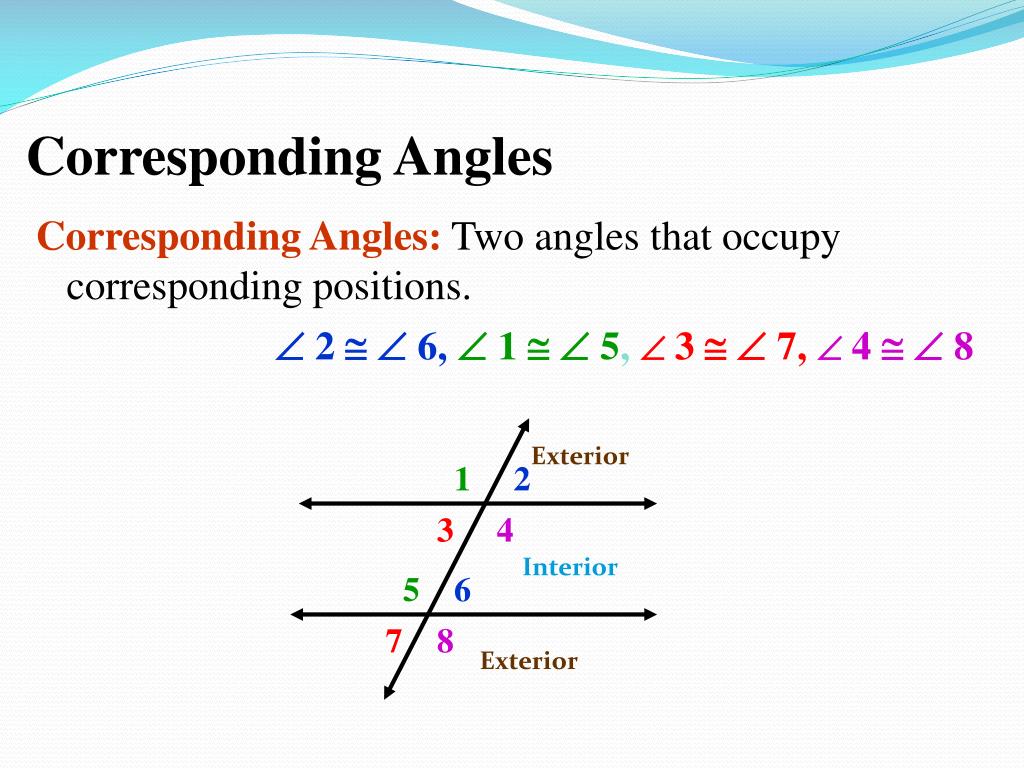

∠1 is an obtuse angle, and any one acute angle, paired with any obtuse angle are supplementary angles. Which marked angle is supplementary to ∠1? In the following figure, there are two parallel lines cut by a transversal. Therefore, you can substitute ∠7 for ∠3 and know that ∠7 and ∠4 are supplementary. Notice also that ∠3 ≅ ∠7, since they are corresponding angles. When parallel lines are cut by a transversal line, any one acute angle formed and any one obtuse angle formed are supplementary.įrom the figure, you can see that ∠3 and ∠4 are supplementary because they are a linear pair. The same reasoning applies to the obtuse angles in the figure: ∠2, ∠3, ∠6, and ∠8 are all congruent to each other.Ģ. ∠4 ≅ ∠5 are alternate interior angles, and ∠5 ≅ ∠7 are vertical angles. In the figure above ∠1, ∠4, ∠5, and ∠7 are all acute angles. When a transversal cuts parallel lines, all of the acute angles formed are congruent, and all of the obtuse angles formed are congruent. ∠8 and ∠7 are a linear pair they are supplementary. Because they are congruent, the measure of ∠8 = 53°. The converse of this axiom is also true according to which if a pair of corresponding angles are equal then the given lines are parallel to each other. They are in the exterior, on opposite sides of the transversal. If two lines which are parallel are intersected by a transversal then the pair of corresponding angles are equal. The angle marked with measure 53° and ∠8 are alternate exterior angles. Use the following diagram of parallel lines cut by a transversal to answer the example problems. Corresponding angles are non-adjacent and congruent. Alternate exterior angles are non-adjacent and congruent.Ĭorresponding angles two angles, one in the interior and one in the exterior, that are on the same side of the transversal. Alternate interior angles are non-adjacent and congruent.Īlternate exterior angles two angles in the exterior of the parallel lines, and on opposite (alternate) sides of the transversal. These pairs are congruent pairs.Īlternate interior angles two angles in the interior of the parallel lines, and on opposite (alternate) sides of the transversal. There are three other special pairs of angles. Parallel Lines and Transversal- Properties, Angles, Interactives and Examples Two or more lines are parallel when they lie in the same plane and never.

There are other supplementary pairs described in the shortcut later in this section. All of these supplementary pairs are linear pairs. Recall that supplementary angles are angles whose angle measure adds up to 180°. Recall that all pairs of vertical angles are congruent. There are several special pairs of angles formed from this figure. In the example below, eight angles are formed when parallel lines m and n are cut by a transversal line, t. The size w of angle AAB is equal to 135 degrees and the size z of angle CCB is equal to 147 degrees. When two parallel lines are cut by a third line, the third line is called the transversal. When two parallel lines are given in a figure, there are two main areas: the interior and the exterior. Angle pairs formed by parallel lines cut by a transversal Adjacent angles: two angles with a common vertex, sharing a common side and no overlap.


 0 kommentar(er)
0 kommentar(er)
